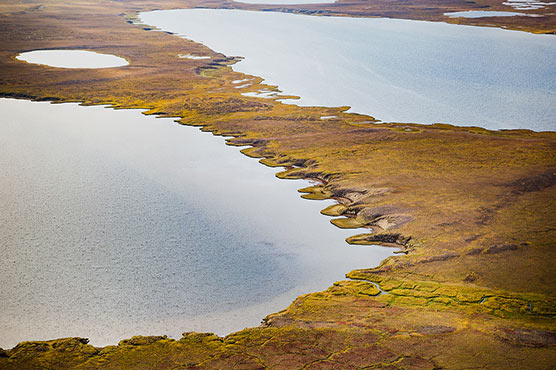NASA detects millions of methane hotspots littering Arctic region

"And we detected 2 million of these hotspots over the land that we covered."
In the remote northern Arctic, greenhouse gas emissions are slipping through the icy cracks. Flying over some of the most inaccessible parts of Alaska and northwestern Canada, NASA researchers have located a shocking amount of thawing permafrost - the frozen layer of soil that blankets much of the region.
If this tundra melts, it releases methane and other carbon emissions into the atmosphere, further accelerating global warming.
Today, we know the Arctic is warming twice as fast as any other place on Earth, but given how frigid and formidable landscape the landscape is, we still don’t know where the most methane is being emitted.
"We consider hotspots to be areas showing an excess of 3,000 parts per million of methane between the airborne sensor and the ground," says Earth system scientist Clayton Elder from NASA’s Jet Propulsion Laboratory.
"And we detected 2 million of these hotspots over the land that we covered."
If that sounds like a lot more than we knew about, you’d be right. For many months of the year, much of the Arctic is inaccessible to scientists, so ground-based observations have covered a mere fraction of the region so far.
While other airborne studies in the past have also noticed Arctic permafrost is melting faster than we thought, NASA researchers see this new technology as a breakthrough, giving us an entirely new perspective on the region.
Using a unique infrared spectrometer (known as AVIRIS-NG), researchers gathered over 400 data runs from flights undertaken in July and August of 2017, covering some 30,000 square kilometres of Arctic land (12,000 square miles).
In total, the trips gathered roughly a billion careful observations on methane emissions, and the results reveal a clear pattern of dispersal centred around water.
"AVIRIS-NG has been used in previous methane surveys, but those surveys focused on human-caused emissions in populated areas and areas with major infrastructure known to produce emissions," says Elder.
"Our study marks the first time the instrument has been used to find hotspots where the locations of possible permafrost-related emissions are far less understood."
Analysing the results, the authors settle on a ‘magic number’ for methane hotspots. On average, they say, these spots are clustered along the banks of lakes, ponds, streams, and other wetland features, usually within 30 to 40 metres (44 yards).
From there on out, the hotspots begin to fade, becoming sparser as they grow more distant from the liquid, until finally, they disappear almost completely, roughly 300 metres (330 yards) away.
The authors are still not clear on why this magic number exists, just that it does. Previous research has indicated that some Arctic lakes, known as thermokarsts, can not only bubble with their own released methane, they can also cause the permafrost around them to melt even faster.
"When the [thermokarst] lakes form, they flash-thaw these permafrost areas," ecologist Katey Walter Anthony from the University of Alaska, Fairbanks explained in 2018.
"Instead of centimetres of thaw, which is common for terrestrial environments, we’ve seen 15 metres of thaw beneath newly formed lakes in Goldstream Valley within the past 60 years."
The factors that lead to this extra melt near wetlands and bodies of water are still unknown, but there are several suspects currently at play.
From their personal experience, Elder and his colleagues suggest these methane hotspots might be clustered around bodies of water because thermokarsts facilitate plant methane diffusion.
"It’s that additional contribution of permafrost carbon - carbon that’s been frozen for thousands of years - that’s essentially contributing food for the microbes to chew up and turn into methane as the permafrost continues to thaw," explains Elder.
And the topography of the region may play a role in defining these methane hotspots, as it influences where vegetation-rich wetlands exist in the Arctic - the flattest areas.
Whatever the reason, it’s clear we need more on-the-ground research, and bodies of water seem like a good place to start.
Methane has a global warming potential some 30 times greater than carbon dioxide, and even if the Paris Agreement is met, Arctic permafrost is expected to shrink 45 percent more, releasing billions of metric tonnes of carbon and methane into the atmosphere.
If we’re headed for a tipping point, we need to know sooner rather than later. In a crisis, timing is everything.
The study was published in the Geophysical Research Letters.


